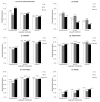Prevalence of cardiovascular disease and risk factors in a rural district of Beijing, China: a population-based survey of 58,308 residents
- PMID: 22248490
- PMCID: PMC3292979
- DOI: 10.1186/1471-2458-12-34
Prevalence of cardiovascular disease and risk factors in a rural district of Beijing, China: a population-based survey of 58,308 residents
Abstract
Background: Cardiovascular disease (CVD) is the leading cause of global disease burden. Although stroke was thought to be more prevalent than coronary heart disease (CHD) in Chinese, the epidemic pattern might have been changed in some rural areas nowadays. This study was to estimate up-to-date prevalence of CVD and its risk factors in rural communities of Fangshan District, Beijing, China.
Methods: A cross-sectional population survey was carried out by stratified cluster sampling. A total of 58,308 rural residents aged over 40 years were surveyed by face-to-face interview and physical examination during 2008 and 2010. The standardized prevalence was calculated according to adult sample data of China's 5th Population Census in 2000, and the adjusted prevalence odds ratio (POR) was calculated for the association of CHD/stroke with its cardiovascular risk factors in multivariate logistic regression models.
Results: Age- and sex-standardized prevalence was 5.6% for CHD (5.2% in males and 5.9% in females), higher than the counterpart of 3.7% (4.7% in males and 2.6% in females) for stroke. Compared with previous studies, higher prevalence of 7.7%, 47.2%, 53.3% in males and 8.2%, 44.8%, 60.7% in females for diabetes, hypertension and overweight/obesity were presented accordingly. Moreover, adjusted POR (95% confidence interval) of diabetes, obesity, stage 1 and stage 2 hypertension for CHD as 2.51 (2.29 to 2.75), 1.53 (1.38 to 1.70), 1.13 (1.02 to 1.26) and 1.35 (1.20 to 1.52), and for stroke as 2.24 (1.98 to 2.52), 1.25 (1.09 to 1.44), 1.44 (1.25 to 1.66) and 1.70 (1.46 to 1.98) were shown respectively in the multivariate logistic regression models.
Conclusions: High prevalence of CVD and probably changed epidemic pattern in rural communities of Beijing, together with the prevalent cardiovascular risk factors and population aging, might cause public health challenges in rural Chinese population.
Figures




References
-
- Zhang L, Qin LQ, Cui HY, Liu AP, Wang PY. Prevalence of cardiovascular risk factors clustering among suburban residents in Beijing, China. Int J Cardiol. 2010;151:46–49. - PubMed

